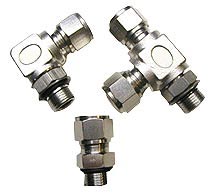Pipe Threads
When we talk about pipe fittings, it means that fittings are used to connect two or more pipes in two ways—either by threads or by slip fit. While metal pipes are threaded, the plastic pipe can be threaded or slip fit. A threaded pipe has screw-threaded ends for assembly or they screw together to connect.
For pipe thread sizes, “½–14 NPT”
identifies a pipe thread with a nominal inside diameter of ½ inch
and 14 threads to the inch and these threads are made according to the
NPT standard. The pipe has a left hand thread if “LH” is
added. The pipe thread standards followed in US are:
- NPT: American Standard Pipe Taper Thread
- NPSC: American Standard Straight Coupling Pipe Thread
- NPTR: American Standard Taper Railing Pipe Thread
- NPSM: American Standard Straight Mechanical Pipe Thread
- NPSL: American Standard Straight Locknut Pipe Thread
The word “taper” mentioned above refers to the difference
between many pipe threads and those on bolts and screws. Pipe threads
not only a make mechanical joint but also a leak proof one. To do this,
the threads become shallower the farther they are from the end of the
fitting or the pipe. The bottoms of the threads taper. The taper is 1/16
inch in an inch.

Because of the taper, a pipe can only screw into a pipe fitting a
little distance before it jams. The standard represents this distance,
the effective thread. The standard also represents another distance, the
engagement, which is the distance the pipe can be screwed in by hand,
without much effort. For workers, it is more easy to know how many turns
to make by hand or with a wrench.
Types of threads:
Various threads available in pipe and pipe fittings are as follows:
- Right-handed or Left-handed Threads
Nearly all threads are oriented so that a bolt or nut or any
fitting can be tightened. By turning it in a clockwise direction,
the item turned moves away from the viewer. And it is loosened by
turning anticlockwise when the item moves towards the viewer . This
is known as a right-handed thread. Left-handed threads are oriented
in the opposite direction. There are also self-tapping screw threads
where no nut or bolt is required.

- Male Threads
In male threads, the threads of the pipe are on the outside. Here,
tapered pipe threads like NPT, BSPT etc. are used sealing without
gaskets.
- Female Threads
In female threads, the threads are on the inside. Here too, like
male threads, tapered pipe threads are used for sealing.
- Male Straight Thread
Pipe threads like UNC, UNF, ASME, etc form Male Straight Thread.
- Female Straight Thread
Straight pipe threads like UNC, UNF, ASME, etc.
- Plain End
This is used to connect or insert into the bell end of the
connecting pipe.
- Bell / Socket / Flare
This represents the end length of increased diameter into which a
pipe end can be fitted.
- Flange
Flanges are used to connect fitting, via bolting or welding. There
are basically two types of flanges, circular and square.
- Compression Fitting
This represents compression nut and ferrule to connect to a mating
pipe.
- Pipe Clamp End
It is so designed so as to attached to run on pipe or other
fitting.
- Barb / Rib
This represents fitting ends to connect only non-rigid pipe or
hose. It is sometimes used with a clamped end.
- Groove
This refers to the installation of a coupling feature like an
o-ring or elastomeric seal.
The points mentioned below will be a guide for the buyers:

